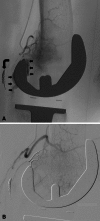Is Embolization an Effective Treatment for Recurrent Hemorrhage After Hip or Knee Arthroplasty?
- PMID: 26220895
- PMCID: PMC4686488
- DOI: 10.1007/s11999-015-4476-6
Is Embolization an Effective Treatment for Recurrent Hemorrhage After Hip or Knee Arthroplasty?
Abstract
Background: Spontaneous recurrent hemorrhage after arthroplasty of the hip or knee is a rare condition. In patients who do not have coagulopathy, the likeliest etiology for hemarthrosis is hypertrophic vascular synovium. Treatments include arthroscopic or open synovectomy, or angiography with embolization; however, because the condition is rare, seldom reported, and debilitating, small case series characterizing the efficacy of any approach are important to allow a collective experience with this condition to emerge.
Questions/purposes: We attempted to (1) determine whether angiography with embolization can prevent recurrent hemarthrosis after hip or knee arthroplasty in a small series of patients with or without coagulopathy, and (2) evaluate complications associated with this intervention.
Methods: Between 2005 and 2014, seven patients presented with spontaneous, recurrent hemarthroses. One patient had polycythemia vera and factor XIII deficiency as underlying illnesses. All patients were treated with selective transarterial embolization, and all had followup at a minimum of 12 months (range, 12-102 months; median, 74 months). Other treatments during this time included hematoma removals and flap operations in one patient, and indications for transarterial embolization included recurrent hemarthrosis. The patients included six men and one woman with a median age of 72 years (range, 61-78 years). Five patients underwent one or more reoperations before transarterial embolization. A diagnostic workup for coagulopathy was performed in all patients; one patient was identified to have polycythemia ruba vera and factor XIII deficiency, however the patient still was treated with transarterial embolization because it was perceived to be the least invasive of available options. No other patients had a diagnosis of coagulopathy. Angiography showed hypervascularity in all patients and a contrast agent showed extravasation in two. Selective transarterial embolization of branches of the internal iliac artery, common femoral artery, deep femoral artery, or the popliteal artery was performed with polyvinyl alcohol particles, microspheres, and/or coils. Patients were followed clinically during 12 to 102 months (median, 74 months) to determine whether the hemorrhages recurred.
Results: Technical success was achieved in all patients. No procedure-related complications were reported. On followup, recurrent hemorrhage was reported in one patient who had a diagnosis of coagulopathy before the procedure. He underwent three reinterventions and five reoperations. Three months after initial embolization, a flap procedure was performed.
Conclusions: In a small series of patients with a minimum followup of 1 year, we found selective transarterial embolization to be effective in patients without underlying coagulopathy in preventing recurrences of spontaneous recurrent hematoma or hemarthrosis of the hip and the knee. This condition is rare, therefore comparative trials are unlikely to be done. Because transarterial embolization is relatively low risk and generally well tolerated, we consider it to be a reasonable approach for consideration with other options such as arthroscopic or open synovectomy and revision arthroplasty.
Level of evidence: Level IV, therapeutic study.
Figures

Similar articles
-
Endovascular Management of Recurrent Spontaneous Hemarthrosis After Arthroplasty.Cardiovasc Intervent Radiol. 2017 Feb;40(2):216-222. doi: 10.1007/s00270-016-1511-2. Epub 2016 Nov 23. Cardiovasc Intervent Radiol. 2017. PMID: 27882429
-
Geniculate artery embolization in the management of spontaneous recurrent hemarthrosis of the knee: case series.J Vasc Interv Radiol. 2013 Mar;24(3):439-42. doi: 10.1016/j.jvir.2012.11.011. J Vasc Interv Radiol. 2013. PMID: 23433418
-
Embolization of the Geniculate Arteries Is an Effective Treatment of Recurrent Hemarthrosis Following Total Knee Arthroplasty That Can Be Safely Repeated.J Arthroplasty. 2018 Apr;33(4):1177-1180.e1. doi: 10.1016/j.arth.2017.11.002. Epub 2017 Nov 24. J Arthroplasty. 2018. PMID: 29224993
-
Geniculate Artery Endovascular Embolization Post-Total Knee Arthroplasty for Hemarthrosis Treatment: A Systematic Review of the Literature.J Endovasc Ther. 2024 Dec;31(6):1158-1164. doi: 10.1177/15266028231157642. Epub 2023 Mar 4. J Endovasc Ther. 2024. PMID: 36869681
-
Selective Embolization Is Safe and Effective for Total Knee Arthroplasty-Associated Recurrent Hemarthroses: A Systematic Review and Meta-Analysis.J Knee Surg. 2021 Jul;34(8):877-885. doi: 10.1055/s-0039-3402482. Epub 2019 Dec 31. J Knee Surg. 2021. PMID: 31891962
Cited by
-
Is there evidence to recommend transcatheter arterial embolisation in adhesive capsulitis: A review of literature.J Orthop. 2022 Feb 11;30:77-82. doi: 10.1016/j.jor.2022.02.008. eCollection 2022 Mar-Apr. J Orthop. 2022. PMID: 35241893 Free PMC article. Review.
-
Unaddressed arterial injuries in revision total hip arthroplasty: mortality outcomes of a low-prevalence complication.Int Orthop. 2020 Jan;44(1):23-29. doi: 10.1007/s00264-019-04358-2. Epub 2019 Jun 20. Int Orthop. 2020. PMID: 31222421
-
Treating recurrent hemarthrosis after knee arthroplasty with selective embolization: a cohort study of 56 patients.Acta Orthop. 2025 Jan 9;96:33-37. doi: 10.2340/17453674.2024.42660. Acta Orthop. 2025. PMID: 39786206 Free PMC article.
References
-
- Insall J, Scott WN, Ranawat CS. The total condylar knee prosthesis: a report of two hundred and twenty cases. J Bone Joint Surg Am. 1979;61:173–180. - PubMed
MeSH terms
LinkOut - more resources
Full Text Sources
Other Literature Sources
Medical
Research Materials

